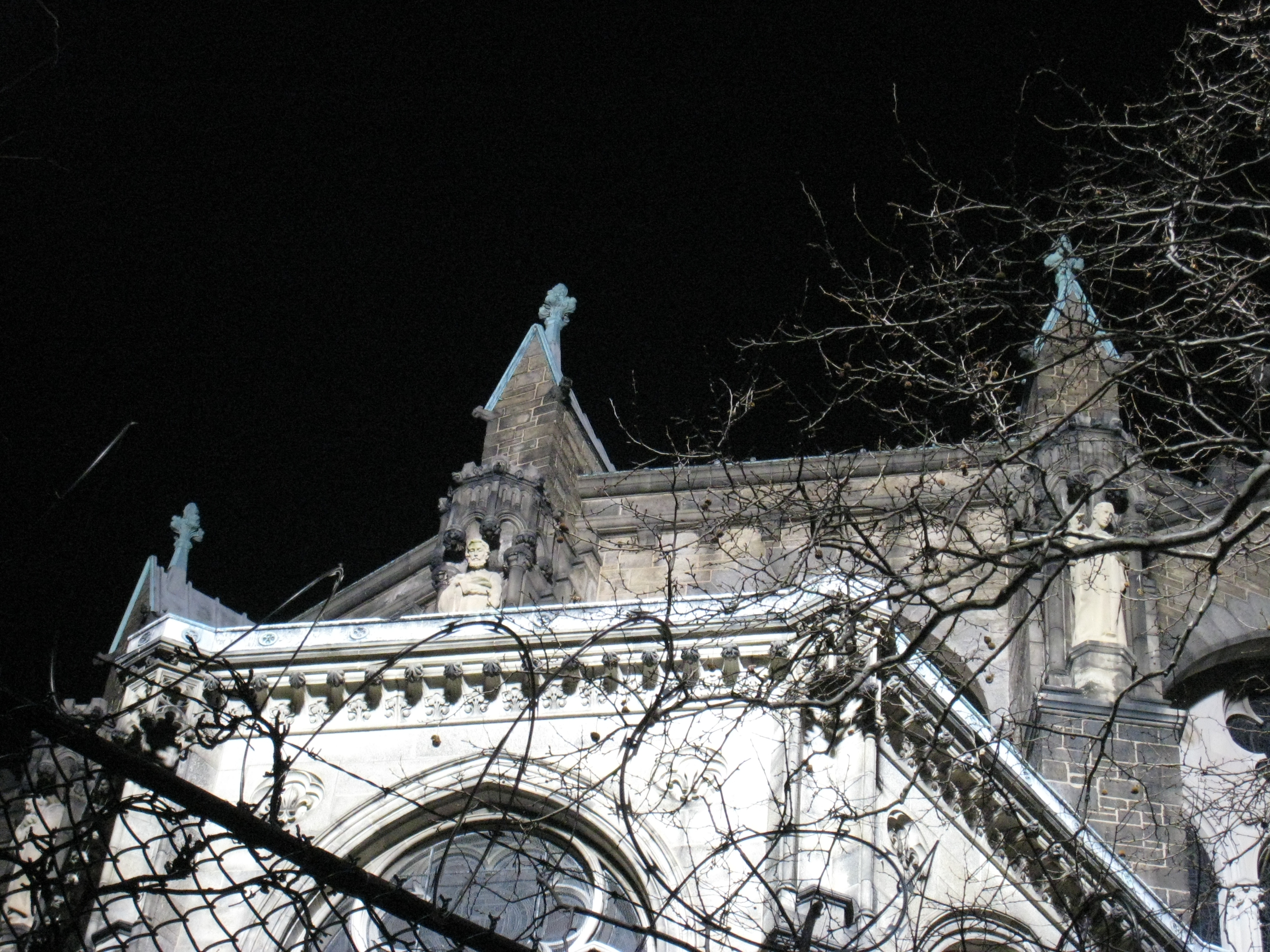Gothic architecture, brightly spotlit against the black night and fenced in with loops of razor wire. One might reasonably think this image depicts a film set, perhaps a dramatization of the early-1980s video game Castle Wolfenstein, which featured special forces infiltrating a medieval castle occupied by the Nazis. Lacking any contextualizing information outside of this photograph, the viewer must make judgments about the scene it depicts based on his or her expectations and associations. In this case, the image is saturated by an unusual lighting like that commonly found in a movie production. Alternatively, when this feature is considered in combination with the high-security fence, it is suggestive of surveillance lighting such as that found at prisons or military bases. Hence the Wolfenstein speculation, which combined these two possibilities into a single reading.
In reality, this photograph shows the back of the cathedral of St. John the Divine, located in the Upper West Side of Manhattan, on a night in March 2007. The lighting, as bright as day, was supplied by massive cinematic lamps raised high on cranes mounted on the backs of tractor-trailers parked in the empty street behind the church, which had been rented out for a private affair––the 60th birthday party of pop icon Elton John. Beyond precisely identifying and situating the depicted scene, this contextual information, which is unknowable from anything visible in the photograph itself, significantly alters our reading of the image by shifting the associations suggested by the various elements. For example, with knowledge of the dozens of A-list celebrities attending the event within the cathedral, the use of spotlights now appears more in line with what is seen at a movie's premier rather than its production. And, with the temporary transformation of the landmark building into a space for the celebration of a notoriously flamboyant and outspoken celebrity, the razor wire takes on a doubled symbolism of exclusion: that of the Episcopal Church's then official denial of the sacrament of marriage to gays and lesbians (which has since been rescinded, but which at the time undoubtedly played a role in the choice of party venue as a form of social commentary), as well as that of the protective bubble surrounding the privileged elite.
An objection could be made that none of the above readings reflect an accurate understanding of the elements in the photograph. The klieg lamps were there solely to pour simulated daylight through the stained glass windows for the benefit of those inside the church, while the security fence was part of the permanent perimeter of the church property and bears no specific relationship to either the lighting or the singular event inside the building. However, a lack of direct correlation doesn't lessen the roles these elements play as visual metonyms for very real conditions. As Saussure demonstrated over a century ago, signifiers are not fixed, but rather require active interpretation based on contextual cues and the negotiation of ranges of possible significance. That is to say, signs often exceed or defy their intended meanings, and the connotations or associations they raise comes as much from their readers as from their producers. In the case of this image, we are looking at a "behind-the-scene" moment, as opposed to the intended (privileged) point of view within the church, where partygoers were no doubt dazzled by the colorful glow of the stained glass windows. The vantage point of this photograph, however, provides space for further reflection on the dynamics of signification in images.
Stained glass is about the confluence of imagery and light. While there are some secular examples––the work of Louis Comfort Tiffany, for one––the strong association of this medium with religion is no accident. When found in a place of worship, the glowing radiance is an obvious allegory for the presence of the divine, illuminating the imagery (and space) that would otherwise remain dark and lifeless. The natural light, which otherwise would be taken for granted as a common feature of the world, is given deeper meaning by its passage through the colored glass. In a church's stained glass window, there is thus a symbiotic relationship between the light, without which the window imagery would not be visible, and the imagery, the religious nature of which activates the light as pointing to the literal presence of god. The synthetic illumination produced by the exterior spotlights at John's birthday party, however, subverts this indexicality and therefore activates the windows in a way that empties them of their original content. The result is necessarily one of pure effect––an aestheticized ambiance comprised of glowing facets of color that have been stripped of any theological meaning. In its very artificiality, this shift serves to visualize the simulacral nature of the divine under the conditions of Postmodernity: God is a creation of Man, not the other way around.
The shift in signification provoked by the spotlit illumination of the stained glass can also be seen as allegorical for the illusory nature of photographic objectivity. Even more than with stained glass, the perceived potency of photographic images derives from their integration of the indexical and iconic semiotic registers. As a result of this unity, photographs present themselves as mechanical recordings providing transparent accounts of reality. Yet, as the preceding discussion of the photograph has shown, they are also inevitably screens for the projection of meaning. Like the artificial activation of the imagery in the windows, which would not be perceivable at all without this outside lighting, a photographic image is likewise only legible––its forms resolving into meaningful configurations––through the viewer's recourse to outside information, contexts, and associations. This is an ongoing process that gives rise to mutable meanings resistant to final closure, yet the image itself––its depicted content––remains unchanged.





